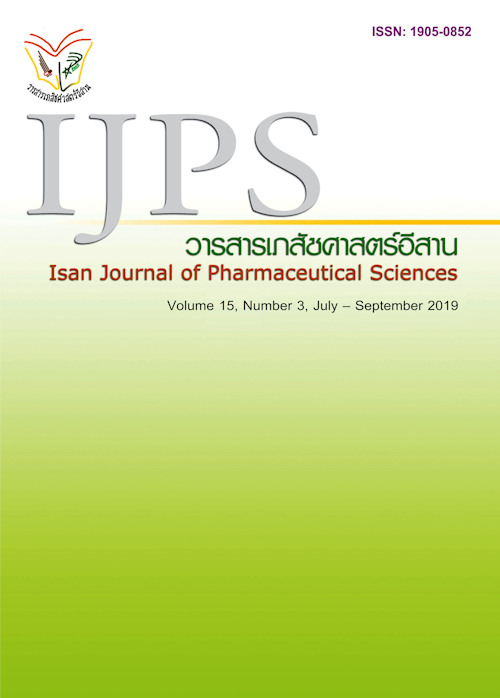Development of Indicators and Criteria of Primary Care Pharmacy for Sub-district Primary Care by Modified Delphi Method Primary Care Pharmacy Indicators & Assessment Criteria by Delphi
Main Article Content
Abstract
Indicators and criteria used for evaluating performance of primary care pharmacy in primary care are formulated by several policy makers but they have some limitations and are difficult to use. No evidence has been found to prove whether such indicators and criteria have been developed systematically. Objective: To develop appropriate indicators and criteria for evaluation of primary care pharmacy in sub-district primary care. Materials and Methods: This study used modified Delphi method. A drafted indicators and criteria was developed from three national evaluation forms. The drafted indicators covered fours domains of primary care pharmacy (drug system development, pharmacy service in primary care, home pharmaceutical care, and consumer protection) and composed of 3 indicator types (input, process, and output indicator). Twenty-five indicators with 4-point-criteria (score of 0, 1, 2, 3) with explanation of indicator’s definition and scoring guideline were proposed and sent out to fourteen experts in primary care pharmacy. Experts rated the appropriateness of each indicator and criteria by using 5-point-scale: 1 (least appropriate) to 5 (most appropriate). Consensus was obtained when the median score was of at least 3.50 and the interquartile range was below 1.50. Results: A draft of indicators and criteria was considered by all experts twice. Consensus was reached for most of indicators and criteria. Only the criteria of the indicator 5.8, namely participation of community networks in order to solve problems regarding consumer protection locally, had the interquartile range greater than 1.50 with diverse opinions of experts, resulted in being removed from the final draft. Eventually, 24 indicators with 96 criteria were considered as appropriate: 9 input indicators, 12 process indicators and 3 output indicators. Conclusion: Twenty-four indicators are appropriate for evaluation of primary care pharmacy in sub-district primary care. A further pilot study should be conducted in order to assure its reliability.
Article Details
In the case that some parts are used by others The author must Confirm that obtaining permission to use some of the original authors. And must attach evidence That the permission has been included
References
Bauer, K. KPIs - the metrics that drive performance management. DM Review 2004; 14(9): 63.
Campbell S M, Braspenning J, Hutchinson A, Marshall M. Research methods used in developing and applying quality indicators in primary care. Quality and Safety in Health Care 2002; 11:358-364.
Crampton P, Perera R, Crengle S, Dowell A, Howden-Chapman P, Kearns R, et al. What makes a good performance indicator? Devising primary care performance indicators for New Zealand. The new Zealand Medical Journal 2004; 117(1191): 1-12.
Health Administration Division, Ministry of Public Health. Report of primary care pharmacy performance based on primary care pharmacy standard in Health Region 10; 2015.
Khemthong P. Evaluation criteria [Internet]. (Cited 4 August 2017). Available from: https://www.eto.ku.ac.th/knowledge/2011/Indicators.pdf
Mateeapiruk P. The Analyze the Performance in Accordance with the Pharmaceutical Standards in Primary Care Unit (PCU), Songkhla Province. South College Network Journal of Nursing Public Health. 2017;4(1):153-170.
Mays AM, Saliba D, Feldman S, Smalbrugge M, Hertogh C , Booker TL, et al. Quality Indicators of Primary Care Provider Engagement in Nursing Home Care. JAMDA 2018; 19:824-832.
Metheesathaphorn A. Development of quality indicators for community nursing of nursing curriculum. North Region College of Nursing, Praborommarajchanok Institute, Ministry of Public; 2001.
National Health Security Office. A handbook of contracting health unit registration; 2016.
Papanicolas I, Smith PC. Health system performance comparison: an agenda for policy, information and research. Copenhagen: Open University Press; 2013.
Pereraa R, Dowellb A, Cramptonc P. Painting by numbers: A guide for systematically developing indicators of performance at any level of health care. Health Policy 2012; 108: 49-59.
Seangsai K. Report of primary care pharmacy performance in Yasothorn fiscal year 2015. Workshop of developing primary care pharmacy; 18 September 2015; The Greenpark Hotel: Yasothorn; 2015.
Strategy and Planning Division, Ministry of Public Health. A handbook of developing quality health promotion hospital; 2016.
Strategy and Planning Division, Ministry of Public Health. National strategic plan 20 years for public health of fiscal year 2018; 2018.
WHO and UNICEF. Report of the International Conference on Primary Health Care. Alma-Ata, USSR, 6 – 12 September 1978.
Yamsakul N. The development of efficiency indicators for primary care units under the Office of the Permanent Secretary for the Ministry of Public Health, Thailand. Ph.D. Thesis; Bangkok: Christian University; 2010.


